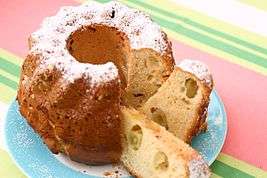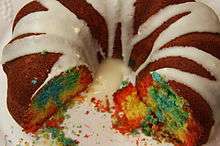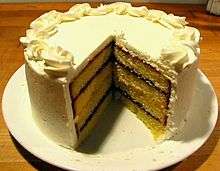Bundt cake
A Bundt cake (/bʌnt/) is a cake that is baked in a Bundt pan, shaping it into a distinctive doughnut shape. The shape is inspired by a traditional European cake known as Gugelhupf, but Bundt cakes are not generally associated with any single recipe. The style of mold in North America was popularized in the 1950s and 1960s, after cookware manufacturer Nordic Ware trademarked the name "Bundt" and began producing Bundt pans from cast aluminum. Publicity from Pillsbury saw the cakes gain widespread popularity.
 A partially sliced Bundt cake | |
| Type | Cake |
|---|---|
| Course | Dessert |
| Place of origin | United States |
| Region or state | Minneapolis |
| Created by | H. David Dalquist |
| Main ingredients | Flour, sugar, eggs |
Etymology
The Bundt cake derives in part from a European brioche-like cake called Gugelhupf. In the north of Germany Gugelhupf is traditionally known as Bundkuchen (German pronunciation: [ˈbʊntkuːxn̩]), a name formed by joining the two words Bund and Kuchen (cake).[1]
Opinions differ as to the significance of the word Bund. One possibility is that it means "bunch" or "bundle", and refers to the way the dough is bundled around the tubed center of the pan.[1] In Dutch, the cake is called "tulband," which is Dutch for 'turban.' The pronunciation of the second part of this word is very similar to that of 'bundt.' Another source suggests that it describes the banded appearance given to the cake by the fluted sides of the pan, similar to a tied sheaf or bundle of wheat.[2] Some authors have suggested that Bund instead refers to a group of people, and that Bundkuchen is so called because of its suitability for parties and gatherings.[3][4]
Uses of the word bund outside of Europe to describe cakes can be found in Jewish-American cookbooks from around the start of the 20th century.[5][6] The alternative spelling "bundte" also appears in a recipe as early as 1901.[7]
Design

Bundt cakes do not conform to any single recipe; instead, their characterizing feature is their shape. A Bundt pan generally has fluted or grooved sides, but its most defining design element is the central tube or "chimney" which leaves a cylindrical hole through the center of the cake. The design means that more of the mixture touches the surface of the pan than in a simple round pan, helping to provide faster and more even heat distribution during baking.[1][8] The shape is similar to that of the earlier European Gugelhupf or Bundkuchen. A Gugelhupf differs from contemporary Bundt-style cakes in that it follows a particular yeast-based recipe, with fruit and nuts, and is often deeper in shape and more decorative.[9] Also similar in shape is the Eastern European Babka, dating from early 18th century Poland.[10]
Today, there is no single recipe for "Bundt cake." Recipes range from spicy pine-nut-and-chili cakes[11][12] to ice cream and fruit concoctions. Nordic Ware and other vendors sell Bundt-style pans in a variety of novelty shapes.[11] Since a toroidal cake is difficult to frost, Bundt cakes are typically either dusted with powdered sugar, drizzle-glazed, or served undecorated. Recipes specifically designed for Bundt pans often have a baked-in filling; Bundt pound cakes are also common.
Since the name "Bundt" is a trademark, similar pans are often sold as "fluted tube pans" or given other similar descriptive titles.[8] The trademark holder Nordic Ware produces Bundt pans only in aluminum, but similar fluted pans are available in other materials.[13]
Rise to popularity

The people credited with popularizing the Bundt cake are American businessman H. David Dalquist and his brother Mark S. Dalquist , who co-founded cookware company Nordic Ware based in St. Louis Park, Minnesota. In the late 1940s,[11] Rose Joshua and Fannie Schanfield, friends and members of the Minneapolis Jewish-American Hadassah Society approached Dalquist asking if he could produce a modern version of a traditional cast iron Gugelhupf dish.[1] Dalquist and company engineer Don Nygren designed a cast aluminum version which Nordic Ware then made a small production run of in 1950. In order to successfully trademark the pans, a "t" was added to the word "Bund".[4] A number of the original Bundt pans now reside in the Smithsonian collection.[14]
Initially, the Bundt pan sold so poorly that Nordic Ware considered discontinuing it.[14] The product received a boost when it was mentioned in the New Good Housekeeping Cookbook in 1963,[15][16] but did not gain real popularity until 1966, when a Bundt cake called the "Tunnel of Fudge", baked by Ella Helfrich, took second place at the annual Pillsbury Bake-Off and won its baker $5,000.[11][15] The resulting publicity resulted in more than 200,000 requests[11] to Pillsbury for Bundt pans and soon led to the Bundt pan surpassing the tin Jell-O mold as the most-sold pan in the United States. In the 1970s Pillsbury licensed the name Bundt from Nordic Ware and for a while sold a range of Bundt cake mixes.[4]
To date more than 60 million Bundt pans have been sold by Nordic Ware across North America.[17] November 15 has been named "National Bundt Day".[18]
See also
- Angel food cake, an American sponge cake normally baked in a tube shaped pan
- Gugelhupf, Austrian, German, and Swiss version with a similar shape
- Wonder Pot, a stovetop pot which uses a similar design
References
- Pfrengle, Hermann (22 January 2005). "Who Brought the Bundt Cake?". The Washington Post. Retrieved 19 December 2012.
- Campbell Franklin, Linda (2003). 300 Years of Kitchen Collectibles (5th ed.). Krause Publications. pp. 187–8. ISBN 978-0-87349-365-9.
- "Bundt Pan Creator H. David Dalquist, 86". The Washington Post. Associated Press. 6 January 2005. Retrieved 19 December 2012.
- Dowell, Sharon (17 May 2006). "Bundt pan fans; Fluted cakes popular for six decades". The Oklahoman.
- "Plain Bund, or Napf Kuchen". Aunt Babette's Cook Book. Cincinnati: Block Pub and Print Co. 1889. pp. 326–327. OCLC 3903063.
- Meier, Lina (1909). "Bund-Kuchen". The Art of German Cooking and Baking. Milwaukee: Wetzel Bros Printing Co. p. 337. OCLC 13378934.
- Kander, Lizzie Black (1901). "Bundte Kuchen". The Settlement Cook Book. Sandusky, OH: American Crayon Co. Retrieved 19 December 2012.
- "Tube Pans". Fante's. Archived from the original on 4 January 2013. Retrieved 20 December 2012.
- Davidson, Alan (2006). The Oxford Companion to Food (2nd ed.). Oxford University Press. p. 441. ISBN 978-0-19-280681-9.
- Berny, Iwona (17 March 2010). "Il Babà - ciastko o niezwykłym smaku i historii" [Babka: a cake with a unique flavor and history] (in Polish).
- Short, Susanna (2007). "And the Bundy was Born!". Bundt Cake Bliss. St. Paul: Minnesota Historical Society Press. pp. 1–4. ISBN 978-0-87351-585-6.
- Susanna Short. "Pine Nut and Chili Bundt with Chili Glaze". The Splendid Table. Retrieved 2019-11-29.
- File:Napfkuchen-Form.jpg
- McKinney, Matt (24 February 2007). "Smithsonian Gobbles up Bundt Pan". Star Tribune. Minneapolis. Retrieved 2007-03-01.
- Anderson, Jean (1997). American Century Cookbook: The Most Popular Recipes of the 20th Century. New York: Clarkson Potter. p. 458. ISBN 978-0-517-70576-6.
- The New Good Housekeeping Cookbook. New York: Harcourt, Brace & World. 1963. OCLC 378017.
- "About Us". Nordic Ware. Archived from the original on 20 December 2012. Retrieved 19 December 2012.
- "National Bundt Day". National Day Calendar.
External links
- "Bundt Cake Recipes". Food Network.
- "Bundt pan". MNopedia.
